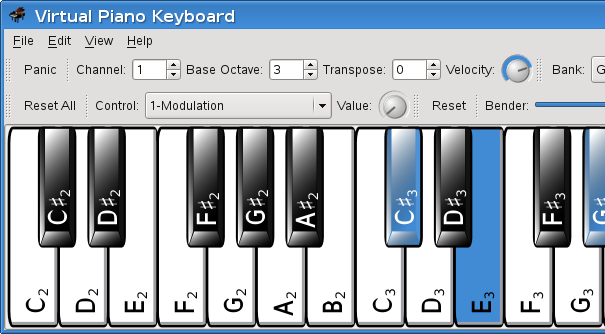
- #PIANO VISUALIZER PROGRAM HOW TO#
- #PIANO VISUALIZER PROGRAM INSTALL#
- #PIANO VISUALIZER PROGRAM ZIP FILE#
- #PIANO VISUALIZER PROGRAM WINDOWS 10#
- #PIANO VISUALIZER PROGRAM SOFTWARE#
You have to enable light support in Synthesia by setting "Key Light" option to "Finger-based channel". If you still want to try, follow this link for instructions. This method is not recommended due to problems with establishing the first connection, especially on devices other than those with Windows 10. Windows: rtpMIDI by Tobias Erichsen | tutorial
#PIANO VISUALIZER PROGRAM SOFTWARE#
You connect your Piano and PC to USB HUB connected to RPi and that's it, everything just works.įor this method you need to use some software on your Synthesia's device and both devices must be connected to the same local network. The only downside is that it cost €39.00 (~48 USD) + shipping. It works with any device that support MIDI over USB, offers the lowest latency and no lost packets. This is, in my opinion, the best way to make connection between RPi and PC. Learning to play with Synthesia We need to make a connection between your PC/MAC/Android. Sudo python3 /home/Piano-LED-Visualizer/visualizer.py -webinterface false By default, web interface works on port 80, but if needed it can be changed with the script's argument -port To connect to the web interface, type the local address of your raspberry pi in the browser, for example http:/192.168.1.10īoth devices must be connected to the same network.

The visualizer comes with a web interface with which you can control the colors of the LED strip, change port settings, run animations of the strip, control sequences and manage midi files, including downloading, uploading, renaming, deleting, and playing. If you don't have a 3d printer, try to find some company or private person who will print it for you. Scroll down to see some photos of the setup I made There should be a gap between RPI and screen so you can solder your wires or just wrap cables around the pins and separate them with heat shrink bands.Īfter connecting all cables as described above everything should fit nicely to case.
#PIANO VISUALIZER PROGRAM HOW TO#
If you are wondering how to connect wires to RPI if screen hat is taking all pins here is a picture of how I did it. When it is closed, the animations are automatically switched off. Attach the switch to the key cover, if available. Optionally, you can connect a switch to BCM pin 12 and GND. There is no point to reinvent the wheel again, here is a nice tutorial (do only the hardware part) Instruction Connecting LED Strip to Raspberry Pi and enabling SPI Note: replace “ with " when editing wpa_nf file. If you want to make your RPi autoconnect to Wi-Fi you need to follow this guide (starting from step 3) After 3-8 minutes (depending on how fast your SD card is) you should see Visualizer menu on RPi screen. If you don't need to connect your RPi to Wi-Fi you can eject SD card from your PC and put it in Raspberry Pi.
#PIANO VISUALIZER PROGRAM ZIP FILE#
#PIANO VISUALIZER PROGRAM INSTALL#
There are two ways, you can use preconfigured system image or install everything manually. Total cost (excluding piano and tablet) should be 75-100 USD Disclosure: All of the links above are affiliate links, which means that without additional costs for you, I will earn a commission if you make a purchase by clicking through it.
#PIANO VISUALIZER PROGRAM WINDOWS 10#



WS2812B LED Strip ( at least 1.5m with 144 diodes/meter) Amazon US | Aliexpress.MicroSD card (16 GB is more than enough) Amazon US | Aliexpress.Raspberry Pi Zero WH Amazon US | Aliexpress | Aliexpress #2.I personally use iConnectivity mio Amazon US ) MIDI to USB interface (if your piano doesn't have USB output) Amazon US | Aliexpress (cheap midi interfaces might not work as intended, I recommend hardware from more known brands.


 0 kommentar(er)
0 kommentar(er)
